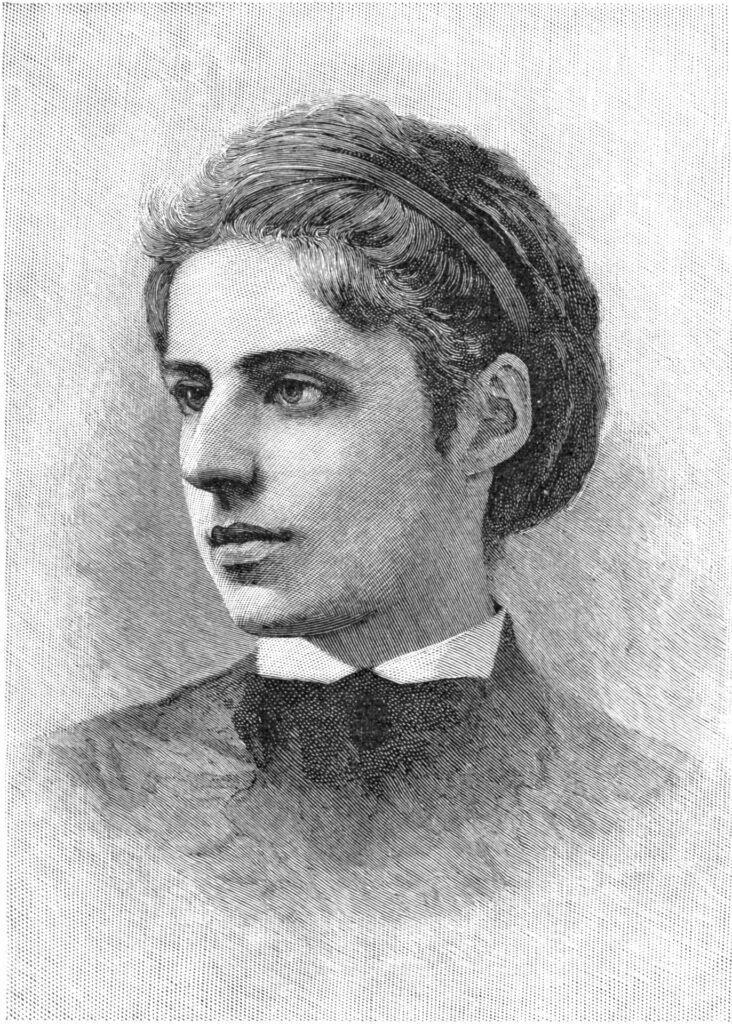
Not like the brazen giant of Greek fame,
With conquering limbs astride from land to land,
Here at our sea-washed, sunset gates shall stand
A mighty woman with a torch, whose flame
Is the imprisoned lightening, and her name
Mother of Exiles. From her beacon-hand
Gloves world-wide welcome; her mild eyes command
The air-bridged harbor that twin-cities frame.
“Keep, ancient lands, your storied pomp!”
Cries she
With silent lips.
“Give me your tired, your poor,
Your huddled masses yearning to breathe free,
The wretched refuse of your teeming shore,
Send these, the homeless, tempest-tossed to me:
I lift my lamp beside the golden door.”
Most of us recognize these famous words as the inscription for the Statue of Liberty. Yet few know that this poem, “The New Colossus,” was written by Emma Lazarus, a major Jewish American literary figure.
Emma Lazarus was born in 1849 in New York City, the fourth of seven children of Esther and Moses Lazarus. Her family were descendents of Sephardic Jews fleeing the Spanish Inquisition who arrived in America even before the American Revolution-her father could trace his ancestry back to the first twenty-three Jews who settled in New York in 1654. Her family was part of the rich society of uptown Manhattan that included elegant homes, private tutors, and literary salons. Emily received a private education that included exposure to classical literature, poetry, and romance languages. She loved reading and, as a teenager, began writing verse, first published by her family. Her poetry was good enough to attract the attention of Ralph Waldo Emerson, who encouraged her writing. In her writing career, Lazarus published numerous poems, essays, and letters, as well as translations of major collections of poems. She was an important figure in New York’s elite literary circles, and corresponded with many important American writers and intellectuals of the time.
News from Russia about the vicious anti-semitic pogroms of 1881 and 1882 kindled an awakening of Lazarus’ commitment to Judaism. When she first met escaping Eastern Europe refugees, she could hardly believe they were Jews. Poor, sick, and uneducated, these immigrants were very different from the upper class New York Jews in her social circle. She became particularly enraged at assimilated American Jews who seemed embarrassed by the unsophisticated Jewish refugees. At that time, many American Jews did not want to associate with these newcomers, because they were afraid that these “different Jews” would reflect badly on the status of their own Jewish community in the United States, and would compromise their success in assimilation into American culture.
Lazarus stopped writing poetry temporarily to assist the arriving Russian Jewish immigrants, often giving them money, food and clothing to help alleviate their poverty. She organized a project to train Jews in industrial trades, which later became the Hebrew Technical Institute. She attended rallies to raise money for Russian Jews and wrote about them in poems and essays. “Until we are all free, we are none of us free,” she pointed out.
Subsequently, Emma Lazarus chose to identify herself as a Jewish American writer. She began to write passionate Jewish poems and essays in support of a Jewish homeland in Palestine, thirteen years before Theodore Herzl founded the Zionist movement. Her best work, a book entitled Songs of a Semite, consisted of Jewish themed poems and lyric drama that celebrated ancient and modern Jewish courage and advocated the idea of a Jewish nationality. She studied Hebrew and translated classic Hebrew poems of the great literary figures of Spain’s golden age of Judaism, including Judah HaLevi and Solomin ibn Gabirol; many of her translations later were incorporated into standard prayer books. Her works regularly appeared in the Jewish press, including the weekly magazine, American Hebrew.
“The New Colossus,” was written in 1883 for a fundraiser auction to build a pedestal for the Statue of Liberty. This sonnet was auctioned in a benefit sale for $21,500, a sum unheard-of for a short piece of poetry. In this verse, Lazarus contrasts the Statue of Liberty with the Greek Colossus of Rhodes, a venerable warrior. Instead, the guardian of America’s gateway is a strong, but nuturing woman, the Mother of Exiles. Lazarus’ vision of the United States as a haven for the refugees of Europe and Russia was the inspiration for the poem, in which America is depicted as the golden land of hope and opportunity for the oppressed.
Emma Lazarus died in 1887, 4 years after composing the sonnet, at the age of 38. In 1903, her poem was engraved on a metal plaque, and attached to the pedestal of the Statue of Liberty. Two of her life’s dreams became reality in the next century: her American dream of the huddled masses of Jewish immigrants successfully integrating into American society and her Jewish dream of a Jewish homeland that would accept all persecuted Jews.
A recent documentary about the Statue of Liberty, written by Ken Burns, opens with a recitation of “The New Colossus.” Yet, despite crediting all the architects, builders, and politicians associated with creating the monument he fails to mention Emma Lazarus’ name! The events of September 11, 2001 deepen our appreciation of the freedoms and opportunities we enjoy in the United States, ideas symbolized by the Statue of Liberty and its inscription, written by Emma Lazarus.
